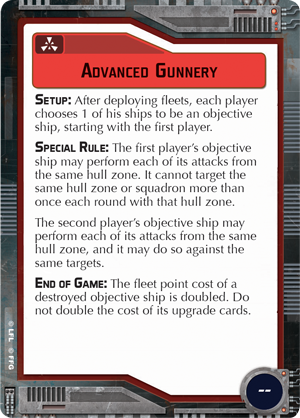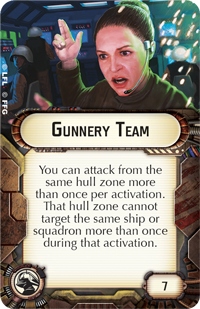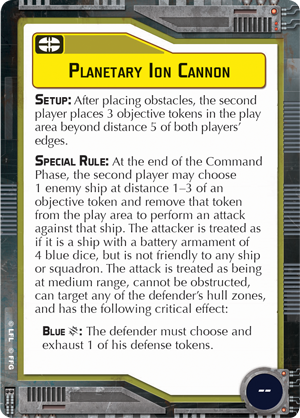Post by Fadril Adren on Jan 27, 2018 14:54:38 GMT -5

"But how could they be jamming us if they don't know… if we're coming?"
–Lando Calrissian, Star Wars: Return of the Jedi
No matter where your battles take you across the Star Wars galaxy, it’s important to keep your mission in mind. Nowhere is this aphorism more apt than in your strategic matches of Star Wars™: Armada. Today, guest writer Ian Cross takes the time to look at the role that objectives play and how you can make the most of them!
Ian Cross on Preparing for the Unknown
Objectives are a driving force behind every game of Star Wars: Armada. Whether you’re facing a friend with a familiar fleet or encountering new opponents in a championship tournament, objectives are what shape the way you deploy, activate, and attack. In this article, we're going to take a look at how you can build your fleet to take advantage of your own objectives, as well as turning your opponent's objectives to serve your own strategy.

One of the first decisions made in any game of Armada is who will be first player and who will be second player. Taking the role of first player is very strong from a tactical perspective, allowing a commander to make the first choice at the start of every round. But second player provides a wealth of strategic options to shape the entire game in your favor. When you’re choosing the objectives that you’ll take to the table, you want to bring options that support your fleet, but you also want options that won’t benefit your opponent.
For example, if an opponent brings the Advanced Gunnery objective with their MC80, it’s a very strong choice for them, since MC80s can’t use Gunnery Team and gain as much benefit as possible from the objective. But if you have an Imperial Star Destroyer at the table, you will be in a better position as the first player to choose that objective than if you had brought a swarm of CR90s.

Gunnery Team allows a ship to fire out of a single hull zone twice in one round, instead of the usual allowance of once-per-round. This is a very powerful upgrade that you could slot onto your own Imperial Star Destroyer, but it’s incompatible with the Advanced Gunnery objective. By placing this upgrade on your ship, you’ve hurt your chances of using one of the strongest and most popular assault objectives in the game. You also telegraph to your opponent that you probably don't have Advanced Gunnery among your own objectives, should you end up as second player.
If you keep this fact in mind when building your fleet, it may give you a good reason to use a less powerful Weapons Team upgrade. This makes your opponent nervous that your objectives might include Advanced Gunnery—and it makes them much less eager to hand you their objectives if they have Advanced Gunnery among their own objectives!
Star Wars: Armada is a game of choices and decisions. The best commanders know how to make their opponents question their own decisions, and how to force a choice between multiple bad options. When you force the first of those choices to be made before the fleets have even deployed, you gain the initiative over your opponent, whether you’re first player or not.
Controlling the Battlefield
In the smaller squadron war that plays out under the shadow of massive capital ships, squadrons with the Strategic keyword offer some of the lowest firepower of any fighters in the game. Still, these squadrons can be more useful than almost any other squadron because of their ability to control objectives. Almost half of the objectives in the game use tokens in a meaningful way. Strategic squadrons give you unparalleled control over those tokens, whether you’re using them yourself or keeping them from your opponent.
The defense objectives Hyperspace Assault and Planetary Ion Cannon both start the game with three objective tokens placed on the board. This initial setup provides a layout of how both players will want to deploy their fleets to take advantage of the dangers represented by those tokens. After the game starts, these tokens will move very little, if at all. But if you have one or more Strategic squadrons, you’re suddenly able to affect the battlefield beyond the initial setup.


As the first player flying into the path of a Planetary Ion Cannon, your Strategic squadrons can race ahead to clear a path. This tactic gives your ships unimpeded access to a lane that your opponent may not have expected or wanted you to take. As the second player, using your own Planetary Ion Cannon, you can use your Strategic squadrons to focus your firepower on a prime target, ensuring that their maneuvers won't save them from the extra attacks that your objective can provide. That planetary firepower would almost never be fully utilized without the help of a Strategic squadron.
The Intel Sweep objective is often a race to the final token, but the Strategic keyword gives you a huge lead in that race, letting you steal tokens right out from under the prow of your opponent's objective ship. With this small change to your fleet, you give yourself a fantastic array of options, no matter how your opponent has built their fleet. Ultimately, by bringing these squadrons to the table, you can enhance your own objectives and hurt your opponent's expectations. Keeping the objectives in mind as you build your fleet helps you respond to any of your opponent's plans.
Second to None
As the game of Star Wars: Armada grows, the ability to create unique fleets does, as well. A first player alpha strike can be devastating, but it’s only as good as your ability to position your fleet. Certain objectives require a different approach to ensure that your opponent won't gain an insurmountable lead, but more options for turning the strategy of the game to one player's favor have already entered the game.

The Grav Shift Reroute upgrade can drastically change the positions of obstacles on the battlefield!
The Contested Outpost objective sees the game begin with obstacles that you and your opponent are attempting to use. By bringing an Interdictor with the Grav Shift Reroute upgrade card, you’re able to move those obstacles, often to such an extent that it will take an entire round for your opponent's ships to make up the distance. An Interdictor may not be the ship that people often think of for a first player alpha strike, but it has unprecedented repair and control abilities. This could be the first step in creating an objective-focused fleet—a fleet that is more interested in creating a points advantage than positioning for a first player attack.
Ready for Anything
The best fleets and the best commanders in Star Wars: Armada are able to respond to any challenge—and that begins with the challenge of whether you will be first or second player. Having a strategy for your fleet is an important part of winning your games, but that strategy is worth nothing if your opponent is able to defeat it before the game has even begun.
Objectives are often chosen as an afterthought once fleet-building is done, but they are as much a part of your fleet as the ships and squadrons you bring. In the same way, how your fleet responds to opposing objectives is as important as how it fights the opposing fleet. Both aspects need equal attention if you want to ensure victory.
When making the decision of how many points to factor into your fleet-building for initiative bid, ask yourself whether your fleet is completely dependent on your preferred placement. If you don't have the ability to respond as either first or second player, it may be worth reevaluating your objectives or your fleet. In doing so, you will provide a less predictable challenge to any opponent, and you will become a more capable commander.
Ian Cross is a Twin Cities local who has been playing Star Wars: Armada at the Fantasy Flight Games Center since it was released. He is a Regional Champion who has been judge for the game at the North American and World Championships in both 2016 and 2017. He gives equal consideration to both factions, but at the table he would have himself taken away if he were ever a part of the Rebel Alliance and a traitor.


